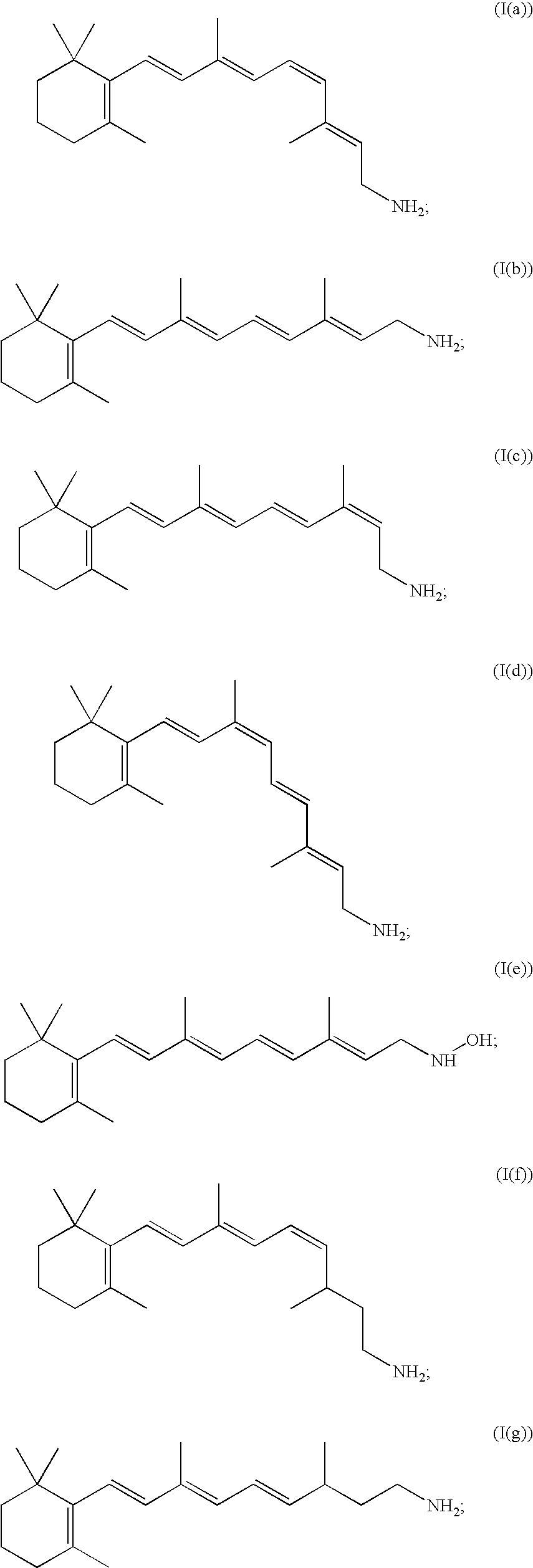Compositions and methods for treatment of ophthalmic diseases and disorders
a technology for ophthalmic diseases and disorders, applied in the field of compositions and methods for treating neurodegenerative diseases and disorders, can solve the problems of blindness worldwide, more serious vision loss, and the death of retinal cells, and achieve the effects of prolonging the viability of retinal cells, preventing retinal cell death, and enhancing or prolonging the survival of retinal cells
- Summary
- Abstract
- Description
- Claims
- Application Information
AI Technical Summary
Benefits of technology
Problems solved by technology
Method used
Image
Examples
example 1
Experimental Procedures
[0239]Materials—Fresh bovine eyes are obtained from a local slaughterhouse (Schenk Packing Co., Inc., Stanwood, Wash.). Preparation of bovine RPE microsornes is performed according to previously described methods (Stecher et al., J Biol Chem 274:8577-85, 1999; see also Golczak et al., supra). All chemicals are purchased from Sigma-Aldrich (St. Louis, Mo.). 11-cis-Retinal is obtained from Dr. Rosalie Crouch (Medical University of South Carolina, Charleston, S.C.). Alternatively, 11-cis-Retinal may be purchased or synthesized as described herein.
[0240]Retinoid preparations—All-trans-retinol is obtained by reduction of all-trans-retinal with an excess of NaBH4 in EtOH at 0° C. and purified by normal phase HPLC (Beckman Ultrasphere Si 5μ 4.5×250 mm, 10% EtOAc / hexane; detection at 325 nm). Purified all-trans-retinol is dried under a stream of argon and dissolved in DMF to a final concentration of 3 mM and stored at −80° C. Retinoid concentrations in EtOH are determ...
example 2
Isomerase and LRAT Reaction
[0246]The capability of several retinylamine compounds to inhibit the activity of visual cycle trans-cis isomerohydrolase (isomerase) was determined.
[0247]Isomerase and LRAT reaction—The isomerase reaction was performed essentially as described previously (Stecher et al., J Biol Chem 274:8577-85 (1999); see also Golczak et al., supra). Bovine Retinal Pigment Epithelium (RPE) microsome membranes were the source of visual cycle trans-cis isomerohydrolase (isomerase).
[0248]RPE microsome membrane extracts may be purchased or prepared according to methods practiced in the art and stored at −80° C. Crude RPE microsome extracts were thawed in a 37° C. water bath, and then immediately placed on ice. 50 ml crude RPE microsomes were placed into a 50 ml Teflon-glass homogenizer (Fisher Scientific, catalog no. 0841416M) on ice, powered by a hand-held DeWalt drill, and homogenized ten times up and down on ice under maximum speed. This process was repeated until the cru...
example 3
In Vivo Murine Isomerase Assay
[0251]The capability of the retinylamine derivatives to inhibit isomerase is determined by an in vivo murine isomerase assay. Brief exposure of the eye to intense light (“photobleaching” of the visual pigment or simply “bleaching”) is known to photo-isomerize almost all 11-cis-retinal in the retina. The recovery of 11-cis-retinal after bleaching can be used to estimate the activity of isomerase in vivo. The regeneration of 11-cis-retinal after the photobleach (3,000 lux of white light for 10 minutes) in CD-1 (albino) mice that have been gavaged orally with compounds dissolved in corn oil containing 10% ethanol is assessed at various time intervals.
Eye Retinoid Extraction
[0252]All steps are performed in darkness with minimal redlight illumination (low light darkroom lights and redfiltered flashlights for spot illumination as needed) (see, e.g., Maeda et al., J. Neurochem 85:944-956, 2003; Van Hooser et al., J Biol Chem 277:19173-82, 2002). Mice (6 weeks ...
PUM
| Property | Measurement | Unit |
|---|---|---|
| wavelengths | aaaaa | aaaaa |
| pH | aaaaa | aaaaa |
| pH | aaaaa | aaaaa |
Abstract
Description
Claims
Application Information
 Login to View More
Login to View More - R&D
- Intellectual Property
- Life Sciences
- Materials
- Tech Scout
- Unparalleled Data Quality
- Higher Quality Content
- 60% Fewer Hallucinations
Browse by: Latest US Patents, China's latest patents, Technical Efficacy Thesaurus, Application Domain, Technology Topic, Popular Technical Reports.
© 2025 PatSnap. All rights reserved.Legal|Privacy policy|Modern Slavery Act Transparency Statement|Sitemap|About US| Contact US: help@patsnap.com



